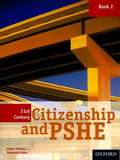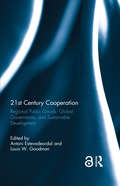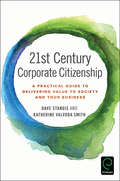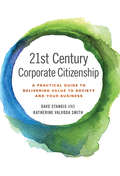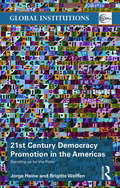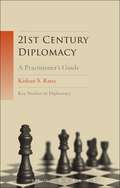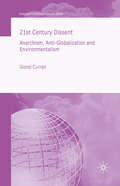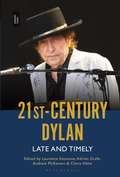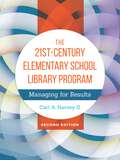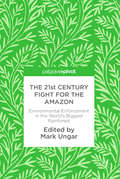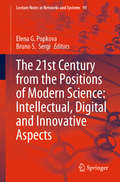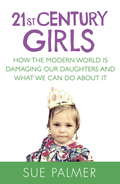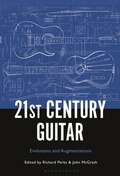- Table View
- List View
21st Century Challenges in Chemical Crystallography I: History and Technical Developments (Structure and Bonding #185)
by D. Michael P. Mingos Paul R. RaithbyThis volume summarises recent developments and possible future directions for small molecule X-ray crystallography. It reviews specific areas of crystallography which are rapidly developing and places them in a historical context. The interdisciplinary nature of the technique is emphasised throughout. It introduces and describes the chemical crystallographic and synchrotron facilities which have been at the cutting edge of the subject in recent decades. The introduction of new computer-based algorithms has proved to be very influential and stimulated and accelerated the growth of new areas of science. The challenges which will arise from the acquisition of ever larger databases are considered and the potential impact of artificial intelligence techniques stressed. Recent advances in the refinement and analysis of X-ray crystal structures are highlighted.In addition the recent developments in time resolved single crystal X-ray crystallography are discussed. Recent years have demonstrated how this technique has provided important mechanistic information on solid-state reactions and complements information from traditional spectroscopic measurements. The volume highlights how the prospect of being able to routinely “watch” chemical processes as they occur provides an exciting possibility for the future. Recent advances in X-ray sources and detectors that have also contributed to the possibility of dynamic single-crystal X-ray diffraction methods are presented. The coupling of crystallography and quantum chemical calculations provides detailed information about electron distributions in crystals and has resulted in a more detailed understanding of chemical bonding.The volume will be of interest to chemists and crystallographers with an interest in the synthesis, characterisation and physical and catalytic properties of solid-state materials. Postgraduate students entering the field will benefit from a historical introduction to the subject and a description of those techniques which are currently used. Since X-ray crystallography is used so widely in modern chemistry it will serve to alert senior chemists to those developments which will become routine in coming decades. It will also be of interest to the broad community of computational chemists who study chemical systems.
21st Century Challenges in Chemical Crystallography II: Structural Correlations and Data Interpretation (Structure and Bonding #186)
by D. Michael P. Mingos Paul R. RaithbyThis volume summarises recent developments and highlights new techniques which will define possible future directions for small molecule X-ray crystallography. It provides an insight into how specific aspects of crystallography are developing and shows how they may interact or integrate with other areas of science.The development of more sophisticated equipment and the massive rise in computing power has made it possible to solve the three-dimensional structure of an organic molecule within hours if not minutes. This successful trajectory has resulted in the ability to study ever more complex molecules and use smaller and smaller crystals. The structural parameters for over a million organic and organometallic compounds are now archived in the most commonly used database and this wealth of information creates a new set of problems for future generations of scientists. The volume provides some insight into how users of crystallographic structural data banks can navigate their way through a world where “big data” has become the norm. The coupling of crystallography to quantum chemical calculations provides detailed information about electron distributions in crystals affording a much more detailed analysis of bonding than has been possible previously. In quantum crystallography, quantum mechanical wavefunctions are used to extract information about bonding and properties from the measured X-ray structure factors. The advent of quantum crystallography has resulted in form and structure factors derived from quantum mechanics which have been used in advanced refinement and wavefunction fitting. This volume describes how quantum mechanically derived atomic form factors and structure factors are constructed to allow the improved description of the diffraction experiment. It further discusses recent developments in this field and illustrates their applications with a wide range of examples.This volume will be of interest to chemists and crystallographers with an interest in the synthesis, characterisation and physical and catalytic properties of solid-state materials. It will also be relevant for the community of computational chemists who study chemical systems. Postgraduate students entering the field will benefit from a historical introduction to the way in which scientists have used the data derived from crystallography to develop new structural and bonding models.
21st Century Citizenship and PSHE: Book 2 (PDF)
by Eileen Osborne Stephanie YatesCompletely revised and updated, this New Edition of the Citizenship and PSHE scheme provides everything you need to deliver the Programmes of Study for Citizenship and Guidelines for PSHE. Broken down into 3 main sections: Personal; Local and National; International
21st Century Cooperation: Regional Public Goods, Global Governance, and Sustainable Development
by Antoni Estevadeordal Louis W. GoodmanThis edited volume explains the importance of regional public goods (RPGs) for sustainable development and shows why they are particularly important in the context of 21st-century international relations. By presenting a new and original data set and by presenting original essays by renowned scholars, this book lays the foundation for what will become an increasingly important focus for both economic development and international relations as well as for their intersection. The volume contains four parts. The first introduces the core issues and concepts that are explored throughout the book as well as a new and original data set on RPGs. The second part further develops specific concepts important for understanding 21st-century RPGs: regional leadership, alliances, networks, and outcomes. The third examines how cooperation takes place worldwide for a range of important RPGs. Finally, the fourth part discusses how public goods are produced in specific regions, stressing that each region has a distinct context and that these contexts overlap in a decentered "multiplex" manner. Global economic cooperation will be different in the 21st century, and this volume will be of interest to students and scholars of global governance, economic development, international political economy, sustainable development, and comparative regionalism.
21st Century Cooperation: Regional Public Goods, Global Governance, and Sustainable Development
by Antoni Estevadeordal Louis W. GoodmanThis edited volume explains the importance of regional public goods (RPGs) for sustainable development and shows why they are particularly important in the context of 21st-century international relations. By presenting a new and original data set and by presenting original essays by renowned scholars, this book lays the foundation for what will become an increasingly important focus for both economic development and international relations as well as for their intersection. The volume contains four parts. The first introduces the core issues and concepts that are explored throughout the book as well as a new and original data set on RPGs. The second part further develops specific concepts important for understanding 21st-century RPGs: regional leadership, alliances, networks, and outcomes. The third examines how cooperation takes place worldwide for a range of important RPGs. Finally, the fourth part discusses how public goods are produced in specific regions, stressing that each region has a distinct context and that these contexts overlap in a decentered "multiplex" manner. Global economic cooperation will be different in the 21st century, and this volume will be of interest to students and scholars of global governance, economic development, international political economy, sustainable development, and comparative regionalism.
21st Century Corporate Citizenship: A Practical Guide to Delivering Value to Society and your Business
by Dave Stangis Katherine Valvoda Smith21st Century Corporate Citizenship is a practical guide to building a successful business in the modern day. It is a book about leveraging all the tools, trends and assets at the disposal of business to drive bottom-line results, value chain resiliency, productivity, innovation, long-term shareowner value, and benefit for the community. This is the book that leverages corporate citizenship as a value-creating enterprise and translates sustainability, corporate responsibility, and social impact to help you create the most successful business possible in tomorrow’s competitive landscape. For the up and coming manager, this book is the crib sheet to the 21st century MBA that you can’t get (yet) in business schools. The tools and insights presented are valuable for every business person thinking about how to differentiate their company and maximize business and social value—from the sole proprietor to those working in a global megacorporation—the concepts explored are ‘must do’ for those working for manufacturing B2B or B2C companies that are managing complex supply chains, global operations, and corporate reputation. This ‘how-to’ handbook presents a step-by-step process aimed at helping you create the most successful business possible in the 21st century competitive landscape, empowering corporate citizenship professionals to accelerate their credibility within their company as an effective contributor who understands their company’s strategy and who creates value.
21st Century Corporate Citizenship: A Practical Guide to Delivering Value to Society and your Business
by Dave Stangis Katherine Valvoda Smith21st Century Corporate Citizenship is a practical guide to building a successful business in the modern day. It is a book about leveraging all the tools, trends and assets at the disposal of business to drive bottom-line results, value chain resiliency, productivity, innovation, long-term shareowner value, and benefit for the community. This is the book that leverages corporate citizenship as a value-creating enterprise and translates sustainability, corporate responsibility, and social impact to help you create the most successful business possible in tomorrow’s competitive landscape. For the up and coming manager, this book is the crib sheet to the 21st century MBA that you can’t get (yet) in business schools. The tools and insights presented are valuable for every business person thinking about how to differentiate their company and maximize business and social value—from the sole proprietor to those working in a global megacorporation—the concepts explored are ‘must do’ for those working for manufacturing B2B or B2C companies that are managing complex supply chains, global operations, and corporate reputation. This ‘how-to’ handbook presents a step-by-step process aimed at helping you create the most successful business possible in the 21st century competitive landscape, empowering corporate citizenship professionals to accelerate their credibility within their company as an effective contributor who understands their company’s strategy and who creates value.
21st Century Democracy Promotion in the Americas: Standing up for the Polity (Global Institutions)
by Jorge Heine Brigitte WeiffenThis volume examines the promotion and defense of democracy in the Americas. Taking the Inter-American Democratic Charter (IADC) of 2001 as a baseline, it charts the evolution of the issue over the past decade. Although it considers historical antecedents, the main focus of the book is on key instances of promotion and defense of democracy in the Western hemisphere since the adoption of the IADC. It analyzes democratic norms, norm enforcement mechanisms and how they work in practice. Special attention is paid to the 2009 Honduras coup, the issues raised by it and the debates that surrounded it, as this was the first instance in which a member state was suspended in accordance with the IADC. Three central themes guide the analysis: the nature of challenges to democracy in Latin America; the role of regional organizations as democracy promoters; and the transformation of Inter-American relations. The book unveils the key achievements and limitations of the OAS in the field and will be of great interest to students and scholars of democratization, US-Latin American relations, international relations of Latin-America and international organizations.
21st Century Democracy Promotion in the Americas: Standing up for the Polity (Global Institutions)
by Jorge Heine Brigitte WeiffenThis volume examines the promotion and defense of democracy in the Americas. Taking the Inter-American Democratic Charter (IADC) of 2001 as a baseline, it charts the evolution of the issue over the past decade. Although it considers historical antecedents, the main focus of the book is on key instances of promotion and defense of democracy in the Western hemisphere since the adoption of the IADC. It analyzes democratic norms, norm enforcement mechanisms and how they work in practice. Special attention is paid to the 2009 Honduras coup, the issues raised by it and the debates that surrounded it, as this was the first instance in which a member state was suspended in accordance with the IADC. Three central themes guide the analysis: the nature of challenges to democracy in Latin America; the role of regional organizations as democracy promoters; and the transformation of Inter-American relations. The book unveils the key achievements and limitations of the OAS in the field and will be of great interest to students and scholars of democratization, US-Latin American relations, international relations of Latin-America and international organizations.
21st-Century Diplomacy: A Practitioner's Guide (Key Studies in Diplomacy)
by Kishan S. RanaIn the 21st century, new kinds of challenges resulting from interdependence among states and globalization have had a determining impact of the conduct of diplomacy.Diplomacy has become multifaceted, pluri-directional, volatile and intensive, due to the increased complexity in terms of actors, dialogues subjects, modes of communication, and plurality of objectives. This unique text, written by a leading scholar and Foreign Service expert, examines all such factors to provide the definitive guide to diplomacy as it is practiced today. With a multitude of examples from around the world, including the US, UK, EU, Africa, Asia, and Latin America, the book covers the spectrum of diplomacy practice, including regional diplomacy, diplomacy of small states, performance management, handling of decisions and crisis, use of information technology, and reform in foreign ministries. Also included are chapters on craft skills and practical exercises.21st Century Diplomacy will be essential to anyone learning diplomacy, and will also support courses in international relations, foreign policy, and intercultural communication.
21st-Century Diplomacy: A Practitioner's Guide (Key Studies in Diplomacy)
by Kishan S. RanaIn the 21st century, new kinds of challenges resulting from interdependence among states and globalization have had a determining impact of the conduct of diplomacy.Diplomacy has become multifaceted, pluri-directional, volatile and intensive, due to the increased complexity in terms of actors, dialogues subjects, modes of communication, and plurality of objectives. This unique text, written by a leading scholar and Foreign Service expert, examines all such factors to provide the definitive guide to diplomacy as it is practiced today. With a multitude of examples from around the world, including the US, UK, EU, Africa, Asia, and Latin America, the book covers the spectrum of diplomacy practice, including regional diplomacy, diplomacy of small states, performance management, handling of decisions and crisis, use of information technology, and reform in foreign ministries. Also included are chapters on craft skills and practical exercises.21st Century Diplomacy will be essential to anyone learning diplomacy, and will also support courses in international relations, foreign policy, and intercultural communication.
21st Century Dissent: Anarchism, Anti-Globalization and Environmentalism (International Political Economy Series)
by G. Curran21st Century Dissent contends that anarchism has considerably influenced the modern political landscape. Curran explores the contemporary face of anarchism as expressed via environmental protests and the anti-globalization movement.
21st-Century Dylan: Late and Timely
by Laurence Estanove, Adrian Grafe, Andrew McKeown and Claire HélieBob Dylan has constantly reinvented the persona known as “Bob Dylan,” renewing the performance possibilities inherent in his songs, from acoustic folk, to electric rock and a late, hybrid style which even hints at so-called world music and Latin American tones. Then in 2016, his achievements outside of performance – as a songwriter – were acknowledged when he was awarded the Nobel Literature Prize. Dylan has never ceased to broaden the range of his creative identity, taking in painting, film, acting and prose writing, as well as advertising and even own-brand commercial production. The book highlights how Dylan has brought his persona(e) to different art forms and cultural arenas, and how they in turn have also created these personae. This volume consists of multidisciplinary essays written by cultural historians, musicologists, literary academics and film experts, including contributions by critics Christopher Ricks and Nina Goss. Together, the essays reveal Dylan's continuing artistic development and self-fashioning, as well as the making of a certain legitimized Dylan through critical and public recognition in the new millennium.
21st-Century Dylan: Late and Timely
Bob Dylan has constantly reinvented the persona known as “Bob Dylan,” renewing the performance possibilities inherent in his songs, from acoustic folk, to electric rock and a late, hybrid style which even hints at so-called world music and Latin American tones. Then in 2016, his achievements outside of performance – as a songwriter – were acknowledged when he was awarded the Nobel Literature Prize. Dylan has never ceased to broaden the range of his creative identity, taking in painting, film, acting and prose writing, as well as advertising and even own-brand commercial production. The book highlights how Dylan has brought his persona(e) to different art forms and cultural arenas, and how they in turn have also created these personae. This volume consists of multidisciplinary essays written by cultural historians, musicologists, literary academics and film experts, including contributions by critics Christopher Ricks and Nina Goss. Together, the essays reveal Dylan's continuing artistic development and self-fashioning, as well as the making of a certain legitimized Dylan through critical and public recognition in the new millennium.
21st Century Economics: Economic Ideas You Should Read and Remember
by Bruno S. Frey Christoph A. SchalteggerEconomics is a science that can contribute substantial powerful and fresh insights! This book collects essays by leading academics that evaluate the scholarly importance of contemporary economic ideas and concepts, thus providing valuable knowledge about the present state of economics and its progress. This compilation of short essays helps readers interested in economics to identify 21st century economic ideas that should be read and remembered. The authors state their personal opinion on what matters most in contemporary economics and reveal its fascinating and creative sides.
The 21st-Century Elementary School Library Program: Managing for Results
by Carl A. IICompact yet remarkably comprehensive, this book covers all the major aspects of school library services, from administration to instruction focused from the elementary school librarian perspective—now updated and expanded to include the latest developments in makerspaces, the Common Core, social networking, and eBooks.How do you accomplish a technology transformation at a time when budgets are extremely limited? What is the proper location for web-based social networking in the school library? What are the best practices for working together with students, parents, and educators? The 21st-Century Elementary School Library Program: Managing for Results is an invaluable resource for answers to these and many more questions, as it brings together in one volume the advice and insights you need to bring your library into the new century.This invaluable guide provides tips and techniques, forms and templates, and advice on everything from staffing and budgeting to collaborating with teachers and other libraries, to Web 2.0 and other new computer tools for building collections and devising special programs. Whether you are just getting started or are a library veteran seeking effective program renewal, this book belongs on your shelf.
The 21st-Century Elementary School Library Program: Managing for Results
by Carl A. IICompact yet remarkably comprehensive, this book covers all the major aspects of school library services, from administration to instruction focused from the elementary school librarian perspective—now updated and expanded to include the latest developments in makerspaces, the Common Core, social networking, and eBooks.How do you accomplish a technology transformation at a time when budgets are extremely limited? What is the proper location for web-based social networking in the school library? What are the best practices for working together with students, parents, and educators? The 21st-Century Elementary School Library Program: Managing for Results is an invaluable resource for answers to these and many more questions, as it brings together in one volume the advice and insights you need to bring your library into the new century.This invaluable guide provides tips and techniques, forms and templates, and advice on everything from staffing and budgeting to collaborating with teachers and other libraries, to Web 2.0 and other new computer tools for building collections and devising special programs. Whether you are just getting started or are a library veteran seeking effective program renewal, this book belongs on your shelf.
A 21st Century Employability Skills Improvement Framework for the Construction Industry (Routledge Research Collections for Construction in Developing Countries)
by John Aliu Clinton Aigbavboa Wellington ThwalaThis book will provide readers with an understanding of the employability concept and develop an employability skills improvement model to enhance the employability of built environment graduates to foster economic development. The developed model determines the influence of generic skills, discipline specific skills, work-integrated learning, emotional intelligence, university-industry collaboration outcomes and 4IR knowledge in predicting the outcomes of improved graduate employability. The model is developed with a theoretical lens on existing frameworks of employability and skills development. Whilst drawing comparisons with countries such as the UK, USA, Australia and Canada, the authors present the results of a two-stage Delphi survey in South Africa as a case study on the current state of skills development and on the skills of the future. The case study is presented in line with the South Africa’s long-term National Development Plan (NDP) aimed at developing the key capabilities and skills of its citizens by ensuring quality education on a broader scale by 2030. As automation continues to rapidly advance, the pressures on universities to revamp and restructure their curricula have become increasingly necessary. This book recommends that higher education institutions urgently need to intensify their efforts by introducing significant modifications to the science and technology curriculum to enable students to develop and acquire competencies in the rapidly emerging areas of artificial intelligence, data science, robotics, advanced simulation, data communication, system automation, real-time inventory operations, cloud computing, and information technologies. This implies that universities’ curriculum should be infused with 4IR thinking within the conventional primary sciences of biology, chemistry, and physics, with greater emphasis on digital literacy to boost 4IR understanding amongst the graduates. The book is therefore of interest to researchers and policy makers in the built environment that are placed in academia, the construction industry or at consultancy levels, it provides significant recommendations for universities as they intensify their efforts to develop graduates for the future.
A 21st Century Employability Skills Improvement Framework for the Construction Industry (Routledge Research Collections for Construction in Developing Countries)
by John Aliu Clinton Aigbavboa Wellington ThwalaThis book will provide readers with an understanding of the employability concept and develop an employability skills improvement model to enhance the employability of built environment graduates to foster economic development. The developed model determines the influence of generic skills, discipline specific skills, work-integrated learning, emotional intelligence, university-industry collaboration outcomes and 4IR knowledge in predicting the outcomes of improved graduate employability. The model is developed with a theoretical lens on existing frameworks of employability and skills development. Whilst drawing comparisons with countries such as the UK, USA, Australia and Canada, the authors present the results of a two-stage Delphi survey in South Africa as a case study on the current state of skills development and on the skills of the future. The case study is presented in line with the South Africa’s long-term National Development Plan (NDP) aimed at developing the key capabilities and skills of its citizens by ensuring quality education on a broader scale by 2030. As automation continues to rapidly advance, the pressures on universities to revamp and restructure their curricula have become increasingly necessary. This book recommends that higher education institutions urgently need to intensify their efforts by introducing significant modifications to the science and technology curriculum to enable students to develop and acquire competencies in the rapidly emerging areas of artificial intelligence, data science, robotics, advanced simulation, data communication, system automation, real-time inventory operations, cloud computing, and information technologies. This implies that universities’ curriculum should be infused with 4IR thinking within the conventional primary sciences of biology, chemistry, and physics, with greater emphasis on digital literacy to boost 4IR understanding amongst the graduates. The book is therefore of interest to researchers and policy makers in the built environment that are placed in academia, the construction industry or at consultancy levels, it provides significant recommendations for universities as they intensify their efforts to develop graduates for the future.
A 21st Century Ethical Toolbox
by Anthony Weston Bob FischerThoroughly optimistic, A 21st Century Ethical Toolbox, Fifth Edition, invites students to approach ethical issues with a reconstructive intent--to make room for more and better options than the rigid "pro" and "con" positions that have developed around tough problems like abortion, climate change, and racism. Employing an accessible, consistently engaging writing style, Anthony Weston and Bob Fischer cover the skills that are vital to making real progress in ethics, including critical thinking, creative problem-solving, moral vision, and genuine dialogue. Provocative selections from a wide range of philosophers, essayists, activists, and students are interwoven with the authors' own discussions. Now for the first time, a comprehensive suite of digital resources is available for this title, including an Instructor's Manual with chapter outlines and lecture suggestions, a Test Bank including multiple choice and essay questions, and Suggested Resources and Web Links. The text is further enhanced by extensive "Exercises and Notes" sections at the end of each chapter and new and expanded "Going Farther" sections between many chapters. Join instructors and students around the country who are using the experiential and applied activities inspired by this "toolbox" of skills to design interactive and collaborative ethics courses.
The 21st Century Fight for the Amazon: Environmental Enforcement in the World’s Biggest Rainforest
by Mark UngarThis book is the most updated and comprehensive look at efforts to protect the Amazon, home to half of the world’s remaining tropical forests. In the past five years, the Basin’s countries have become the cutting edge of environmental enforcement through formation of constitutional protections, military operations, stringent laws, police forces, judicial procedures and societal efforts that together break through barriers that have long restrained decisive action. Even such advances, though, struggle to curb devastation by oil extraction, mining, logging, dams, pollution, and other forms of ecocide. In every country, environmental protection is crippled by politics, bureaucracy, unclear laws, untrained officials, small budgets, regional rivalries, inter-ministerial competition, collusion with criminals, and the global demand for oils and minerals. Countries are better at creating environmental agencies, that is, than making sure that they work. This book explains why, with country studies written by those on the front lines—from national enforcement directors to biologists and activists.
The 21st Century Fight for the Amazon: Environmental Enforcement in the World’s Biggest Rainforest
by Mark UngarThis book is the most updated and comprehensive look at efforts to protect the Amazon, home to half of the world’s remaining tropical forests. In the past five years, the Basin’s countries have become the cutting edge of environmental enforcement through formation of constitutional protections, military operations, stringent laws, police forces, judicial procedures and societal efforts that together break through barriers that have long restrained decisive action. Even such advances, though, struggle to curb devastation by oil extraction, mining, logging, dams, pollution, and other forms of ecocide. In every country, environmental protection is crippled by politics, bureaucracy, unclear laws, untrained officials, small budgets, regional rivalries, inter-ministerial competition, collusion with criminals, and the global demand for oils and minerals. Countries are better at creating environmental agencies, that is, than making sure that they work. This book explains why, with country studies written by those on the front lines—from national enforcement directors to biologists and activists.
The 21st Century from the Positions of Modern Science: Intellectual, Digital and Innovative Aspects (Lecture Notes in Networks and Systems #91)
by Elena G. Popkova Bruno S. SergiThese proceedings gather the best papers presented at the “10th International Scientific and Practical Conference – the 21st Century from the Positions of Modern Science: Intellectual, Digital and Innovative Aspects,” which was organized by the non-profit organization “Institute of Scientific Communications.” The conference took place on May 23–24 in Nizhny Novgorod, Russia, with support from Minin Nizhny Novgorod State Pedagogical University. The chief advantage of these proceedings are their multidisciplinary character – they include articles and empirical studies addressing various fields, including economics, the social sciences, and law. Accordingly, the target audience is broad, covering scholars, researchers, independent experts, entrepreneurs, and government workers, who are interested in issues concerning: measuring and accelerating socio-economic development; the formation and evolution of the digital society and digital economy; the role of economic systems and economic subjects in the 21st-century technological revolution (the fourth industrial revolution); development and implementation of AI; development and application of intellectual resources in economic activities; and innovations in the economy.
21st Century Girls: How Female Minds Develop, How to Raise Bright, Balanced Girls
by Sue PalmerAn absolute must-have parenting guide to raising girls in the 21st century.'There can be no keener revelation of a country's soul than the way it treats its children.' Nelson MandelaChildhood, as a stage in human development, has been steadily eroded. Children today are introduced to 21st-century adult values and behaviour at an increasingly early age, long before they are developmentally ready to cope with them. We expend immense time and effort attending to their material needs while simultaneously neglecting their developmental needs.In this important polemic, Sue Palmer believes that if we do not get a grip on this problem soon, the increase in developmental disorders, behavioural difficulties and mental health problems recorded by experts over recent decades will soon spiral out of control.Sue discusses challenges faced in the 21st century including:-the problems facing parents in an age of materialism-the way gender wars have intensified those problems-the debate about the 'female brain'-the reasons why contemporary culture can be so damaging for children, especially girls-the challenges involved in detoxifying family lifeEvery parent, grandparent, teacher and carer of girls needs to read this book.
21st Century Guitar: Evolutions and Augmentations
by John McGrath Richard PerksIn the 21st Century, the guitar, as both a material object and tool for artistic expression, continues to be reimagined and reinvented. From simple adaptations or modifications made by performers themselves, to custom-made instruments commissioned to fulfil specific functions, to the mass production of new lines of commercially available instruments, the extant and emergent forms of this much-loved musical instrument vary perhaps more than ever before. As guitars sporting multiple necks, a greater number of strings, and additional frets become increasingly common, so too do those with reduced registers, fewer strings, and fretless fingerboards. Furthermore, as we approach the mark of the first quarter-century, the role of technology in relation to the guitar's protean nature is proving key, from the use of external effects units to synergies with computers and AR headsets. Such wide-ranging evolutions and augmentations of the guitar reflect the advancing creative and expressive needs of the modern guitarist and offer myriad new affordances.21st Century Guitar examines the diverse physical manifestations of the guitar across the modern performative landscape through a series of essays and interviews. Academics, performers and dual-practitioners provide significant insights into the rich array of guitar-based performance practices emerging and thriving in this century, inviting a reassessment of the guitar's identity, physicality and sound-creating possibilities.


